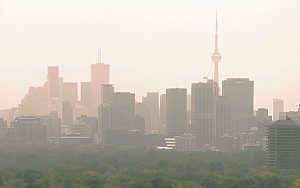Users of a newly-enhanced mobile weather app get a revealing look at the quality of the air around them, thanks to augmented reality (AR). They may not like what they see.

WeatherBug’s mobile app provides a personal, real-time, location-specific air quality index information.
The Air Quality feature that’s now part of the WeatherBug mobile app gives an eye-opening view of what we are breathing, including real-time graphic representations of the many kinds of particulate matter that’s floating all around us.

The folks at WeatherBug identified the need for a capable and easy-to-access personal tool that would help users see what they are breathing.
Using the power of cloud computing, artificial intelligence and machine learning, WeatherBug delivers more than weather predictions: it serves up hyper-local observations of what air quality looks like at street level and it offers air quality forecasts so that users can minimize their exposure to airborne pollutants.
(Minimizing one’s exposure to complex privacy agreements is, as always, another matter: mobile app developer WeatherBug is a division of xAd, Inc. a multi-platform marketing and advertising company now doing business as GroundTruth, a data science and intelligence firm. GroundTruth enthuses in its corporate biography that its data foundation “sees 2 out 3 smartphone users” and tracks more than “30 billion physical visits annually across 21 countries globally.”)
Of course weather has a big impact on our lives. At a more, uhh, granular level, air quality has an equally profound effect, influencing our personal health and safety as well as our economy’s productivity and profitability.
From pollen to industrial pollution, from traffic-related smog to forest fires, air quality is the result of several factors, many of which change daily. But the impacts are much more long-lasting.

Available for iOS and Android smartphones, the WeatherBug app and new Air Quality feature make visible many of the pollutants that do the most harm to human health, like ozone (O3), sulfur dioxide (SO2), carbon monoxide (CO), nitrogen dioxide (SO2) and fine particles (PM2.5 and PM10).
Lots of scientific reports link air pollution to various health problems; factors such as the type of particulate matter in the air and the size of the particles themselves can really exaggerate those problems.
In fact, air pollution is cited as the fourth leading cause of premature deaths, according to the World Bank and Institute for Health Metrics and Evaluation (IHME), and that has an economic impact that costs the global economy some $225 billion.
Something In The Air
Against the backdrop of rising concerns over environmental degradation at a global level, the folks at WeatherBug identified the need for a capable and easy-to-access personal tool that would help users see what’s in the local air they are breathing.
“[O]ur goal is to arm people with a smarter tool so they can stay safer and healthier” said WeatherBug’s President & and General Manager, Olivier Vincent.“When it comes to timely and precise hyper-local, hyper-relevant weather information, our scale and verified level of accuracy gives people and businesses a powerful ‘weather vane’ in the palm of their hand,” he added.
Available for iOS and Android smartphones, the WeatherBug app and new Air Quality feature make visible many of the pollutants that do the most harm to human health, like ozone (O3), sulfur dioxide (SO2), carbon monoxide (CO), nitrogen dioxide (SO2) and fine particles (PM2.5 and PM10).
The app creates imagery of the surrounding air quality by animating the movement of those detected particles on-screen. Coloured heat maps can show changes in air quality, and forecasts of up to 16 hours can be generated, whether you are standing at Yonge and Bloor in Toronto or a campground in Banff National Park.

WeatherBug gets much of its functionality from the cloud, and the WebGL 2 toolkit and development platform offered by Amazon Web Services (AWS) called Amazon Sumerian.
WeatherBug gets much of its functionality from the cloud, and the WebGL 2 toolkit and development platform offered by Amazon Web Services (AWS) called Amazon Sumerian. Mixed reality app developers can edit, update and release new features almost instantly while working in the Sumerian environment, Vincent explained.
The hyper-local air quality updates that these technologies can deliver are not only eye-opening, they can be life-saving. Air quality surely affects everyone, but it is the elderly, children and those with existing heart and respiratory diseases that are at even greater risk for developing air pollution-related health effects due to their weakened immune and respiratory systems.
And while pollution levels have decreased somewhat over the years thanks to government regulations and industry interventions, particles in the air still pose serious threats, especially particles generated from vehicle exhaust and industrial usage, such as coal-fired power plants and petroleum refineries.
The Air That We Breathe
It’s estimated that roughly one-third of the North American population lives in areas with high levels of particle pollution because of those factors, and that increases their risk for aggravated asthma, breathing difficulties and even cardiovascular problems.
While Canada has taken steps to improve air quality, the country’s eighth place ranking (among 16 peer countries) on a list of respiratory deaths (an average of 63.1 deaths per 100,000 people) shows there is still work to be done. Ontario’s shuttering of its coal plants, for example, helped clear the air and improve the lives of asthma sufferers, for example, but more than two million Canadians have asthma, and many do not have it under control despite effective treatment being available.
So while using the app to see real-time graphic representations of the many kinds of particulate matter floating all around us is useful, and knowing how such particles negatively affects the quality of the air we breathe and ultimately our own health is crucial, eliminating pollution and particulate matter is what we really want to see.

Pollution levels have decreased somewhat over the years thanks to government regulations and industry interventions, but particles in the air still pose serious threats to human health and economic stability.
-30-



